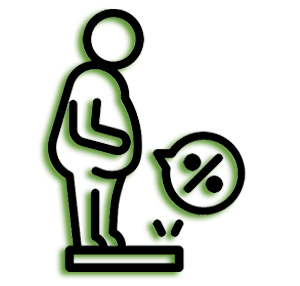
28 Jul WHY FAT LOSS IS SUCCESSFUL WEIGHT LOSS
After the American Medical Association officially declared obesity a chronic disease in July 2013, more doctors and medical providers naturally sought to learn about the biological mechanisms driving the condition, and the optimal treatment approaches for it. One of the surprising things they may have discovered is that numbers on the scale tell only part of the story about how weight impacts overall health. In short, what they’ve learned is that it’s all about the fat.
While total body weight is a very solid indicator of health status, it’s really fat percentage that is key. Everybody requires a minimum amount of fat in order to perform bodily functions and daily activities, but too much of it has proven to be detrimental. Excess fat, especially visceral fat coated around the organs, not only weighs the body down but it has been identified as a substance that has the ability to actively damage healthy body cells. You might think of it like Slimer, the green ghost in the movie Ghostbusters. While at first, he seemed like a fairly harmless blob, his mission was to create havoc. That is what excess body fat is out to do, too, especially if it is situated around your middle. Visceral belly fat is commonly known as the most dangerous type of fat that is linked to type 2 diabetes, heart disease, hypertension, and a slew of other chronic conditions.
It might be assumed that only people who have high overall body weight are at risk of having dangerously high body fat percentage, but this is not at all the case. There are people who have been diagnosed as skinny fat, which means that their scale and BMI numbers seem to indicate good health, but their fat percentages put them at risk for chronic disease. This is why it is critical for everyone to get screened for fat percentage, and not just those whose total body weight outwardly indicates health risks.
So how do you know if you are carrying around too much body fat? Traditionally there have been two primary ways to measure it, both on opposite ends of the cost scale. On the low end are skin calipers, which if used correctly, can produce fairly accurate results. Unfortunately, it is very easy to use them incorrectly. The other downsides of calipers are that they require you to pinch folds of skin on multiple parts of your body and require manual calculations using a mathematical formula to determine your body fat percentage. In other words, while they are cheap, calipers are a pain in the rear. On the other end is the DEXA scan, which is often called the gold standard in body composition measurement. This test requires you to lie still on a table for five to ten minutes while a body scan hovers over you, collecting data on different parts of your body. The DEXA report on body fat and composition is impressive, but the test is very pricey.
Luckily there are now much easier, more cost-efficient options for measuring body fat that do not require having an advanced degree in mathematics. New scale technology has emerged in recent years that can measure total and compartmental fat body percentages. These scales range from simple home scales to those found in providers’ offices and hospitals. The accuracy of the readings will vary depending on the sophistication of the technology, so it’s best to do your research when deciding on the device to rely on for your personal body fat percentage measurements.
While having greater access to body fat measurements is a giant step forward in the battle against obesity, it is still only a step. Knowing your numbers is not enough. In order to make truly meaningful improvements, you still need the education, tools, and guidance to make fat reduction a reality. Your fat percentage needs to be put into the context of a treatment plan that works for you in the long term. Just like any other health condition, your weight needs to be actively managed for a lifetime. It may sound a little strange, but let fat be your guide.


